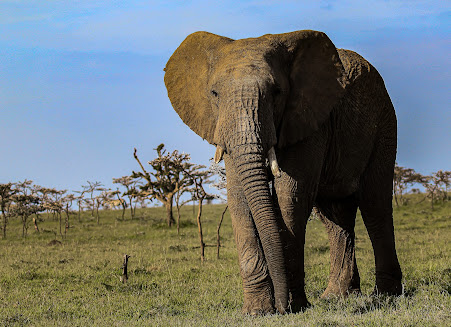The elephant is by far the largest land mammal
Elephants - description and characteristics
Being
herbivores, elephants have few enemies and will not attack anyone. Today they
can be seen in the wild, not only as pets, but also in national parks, nature
reserves, circuses and zoos. We know everything about elephants, including
their lifespan, their diet, and how long they take to become pregnant. But
secrets romain.
How much does an elephant weigh?
The elephant's skeleton
The elephant's
skeleton is strong and can carry a lot of weight. The body is massive and
muscular. The head is enormous and has a projecting brow. The movable ears are
their adornment and serve to regulate heat and communication between tribes.
When the herd is attacked, the ears are moved vigorously to intimidate the
enemy. The legs are also unique. Contrary to popular belief, these giants are
loud and clumsy, but they walk almost silently. Its feet are covered with thick
pads of fat that cushion its gait. It is distinguished by its ability to bend
its knees and has two kneecaps. The animal has a small tail that ends in a
hairless tuft. The young are usually carried by their mother to keep them
company.
Elephant trunk
Seeing and hearing elephants
Skin
The large
mammal has a thick gray or brown skin, full of wrinkles and folds. Its skin is
covered with sparse, stiff hairs found only on the calves. Adults have almost
none.
The color
depends directly on the habitat, as elephants often cover themselves with soil
and clay to protect themselves from insects. This is why some of them have a
brown or even pink appearance.
Among the giants, albino animals are very rare, but they do exist. In Siam they are considered symbolic animals. White elephants were taken especially for kings.
Jaws
The jewels
of giants are their tusks, the older they are, the longer they are. However,
not all are the same size. The female Asian elephants, for example, like the
rarer males, originally had no such ornaments. The tusks go into the jaws and
are considered incisors.
An
elephant's teeth provide information about its life expectancy. The teeth wear
out year after year, but new teeth grow behind the old ones. It is known how
many teeth the mouth of an elephant has. As a rule, there are four molars.
There are some differences in appearance between Indian and African elephants, which will be discussed later.
Types of Elephants
- The answer to the question of which is larger, the Indian elephant or the African elephant, is simple. The one that lives in Africa: elephants weigh 1.5 to 2 tons more and are much taller.
- The female Asian elephant has no tusks, while the female African elephant has all tusks.
- There are some differences in the shape of the body, such as the back of the Asian type being higher than the height of the head.
- African animals have large ears.
- African giants have a slightly thinner trunk.
- Indian elephants are more easily domesticated than African elephants and are almost impossible to tame.
The fact that crossing an African trunk with an Indian trunk does not produce offspring indicates a difference at the genetic level.
The lifespan of an elephant is determined by its living environment and the availability of sufficient food and water. It is said that African elephants live slightly longer than others.
The elephant's way of life
The animals are very social: they form herds, led by the oldest and most experienced female. She leads her fellow elephants to feeding areas and keeps them in order.
Scientists have come to some interesting conclusions. All individuals are related. As a rule, they are immature females and males. Adult males leave their families and often live alone or with similar bachelors. They approach familiar flocks only when they are ready to breed and at the call of females.








0 Comments:
Post a Comment
Subscribe to Post Comments [Atom]
<< Home